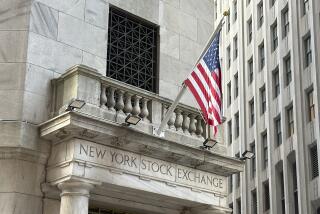A jump in consumer prices renews inflation fears, but investors take it in stride

- Share via
Reporting from Washington — Consumer prices jumped more than expected last month, the Labor Department said Wednesday, adding to the fear of higher inflation that has roiled financial markets in recent days.
But after being shaken initially by the news, investors took it in stride, and the major U.S. stock indexes closed higher for the fourth-straight session.
The consumer price index increased 0.5% in January, up from 0.2% the previous month and well above analyst estimates. The annual inflation rate was 2.1%, the same as it was for the 12 months that ended Dec. 31.
Higher prices for energy, particularly gasoline, as well as for apparel, fueled the sharp increase in the index, which recorded its largest month-over-month jump since September.
Although the consumer price index is not the most important measure of inflation, its release Wednesday took on outsized importance as investors scrambled for any new details about the direction of the economy.
The report roiled stocks at first.
Futures for the Dow Jones industrial index were up about 150 points before the Labor Department released the consumer price index. The higher-than-expected inflation led those Dow futures to drop significantly, indicating the index would open lower.
The Dow opened down more than 100 points but then turned positive, closing up 253.04 points, or 1%, at 24,893.49. . The broader Standard & Poor’s 500 index increased 1.3%, and the technology-heavy Nasdaq composite was up nearly 1.9%.
Concerns that inflation is accelerating, which could lead to higher interest rates, caused last week’s severe stock market declines. And the new data on consumer prices rekindled some of those concerns Wednesday, but was tempered because the annual inflation rate held steady and retail sales declined.
“January inflation did come in hot and higher than expected, there’s no doubt about it … but it’s not too alarming,” said Scott Anderson, chief economist at Bank of the West.
The Commerce Department reported Wednesday that retail sales fell unexpectedly in January, posting their biggest drop in nearly a year. Sales fell 0.3% after a flat December, as Americans cut back on purchases of automobiles and building supplies.
Anderson said the disappointing retail sales data indicate that inflationary pressures from higher consumer spending haven’t developed, despite many workers receiving one-time bonuses linked to the tax cut legislation enacted late last year,
“The narrative doesn’t hold together if inflation is being driven up by demand, the strengthening of the labor market and wage growth, because it wasn’t visible in the retail sales data,” he said.
The so-called core consumer price index, which excludes often-volatile food and energy costs, increased 0.3% in January. That was up from 0.2% the previous month.
The annual rate for the core consumer price index held steady last month at 1.8%.
The Federal Reserve has an annual inflation target of 2%, a level that indicates rising wages but not an overheating economy.
Inflation has been stubbornly low throughout the recovery from the Great Recession, which has helped keep interest rates at historically low levels and made stocks an attractive investment option.
Central bank policymakers monitor all inflation measures, including another that covers wholesale prices. But they judge their annual target on the federal government’s broader personal consumption expenditure price index, which tends to show lower inflation than the consumer price index.
The consumer price index measures the change in prices paid by urban consumers for a variety of goods and services, including food, housing, clothing, healthcare and recreation.
The consumer price index only covers purchases made directly by consumers. The personal consumption expenditures price index is calculated differently and includes more services, such as healthcare paid for by employer-provided insurance, and Medicare and Medicaid.
The PCE price index showed a 1.7% increase in the 12 months ended Dec. 31, the most recent data available. That was down from 1.7% for the 12-month period that ended Nov. 30.
The core PCE price index, which excludes food and energy prices, was up 1.5% year over year through Dec. 31, holding steady from the previous reading.
Inflation fears were sparked Feb. 2 by the latest jobs report.
It showed that average hourly earnings in January jumped 2.9% over the previous 12 months. That was the largest year-over-year percentage gain since 2009. But it’s unclear whether wage growth has really taken off, causing analysts and investors to look to other barometers to gauge inflation.
Twitter: @JimPuzzanghera
UPDATES:
2:10 p.m.: This article was updated with the market close and additional analysis.
8:20 a.m.: This article was updated with new market figures.
7 a.m.: This article was updated with early market figures.
6:45 a.m.: This article was updated with data about retail sales, comments by Scott Anderson of Bank of the West, and the stock market opening.
This article was originally published at 5:50 a.m.
More to Read
Inside the business of entertainment
The Wide Shot brings you news, analysis and insights on everything from streaming wars to production — and what it all means for the future.
You may occasionally receive promotional content from the Los Angeles Times.











